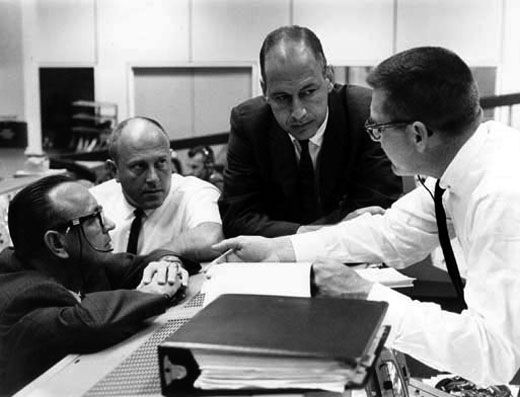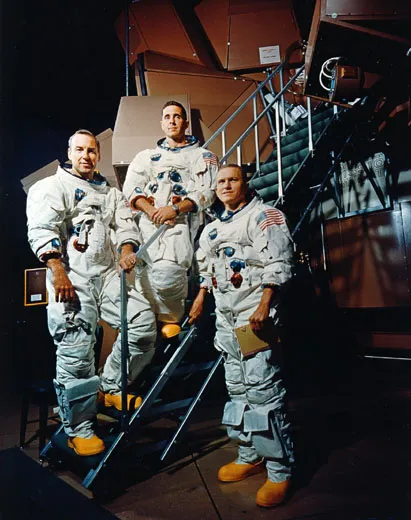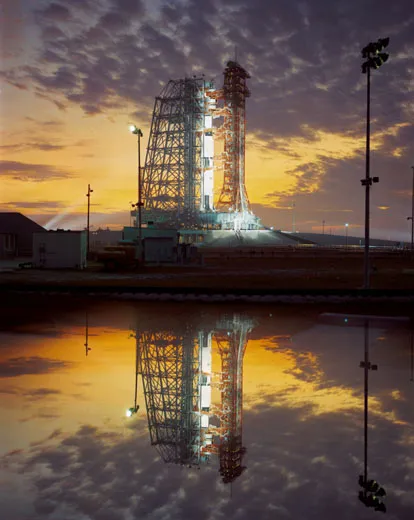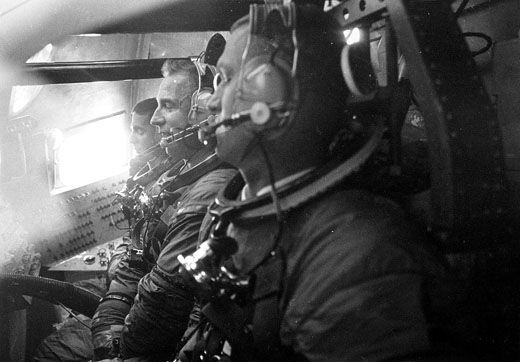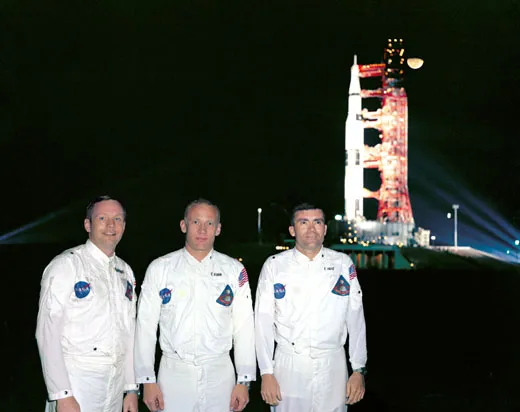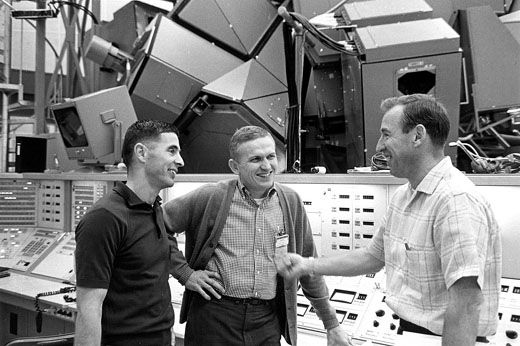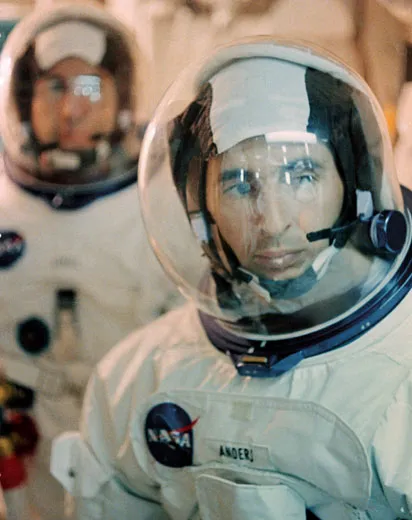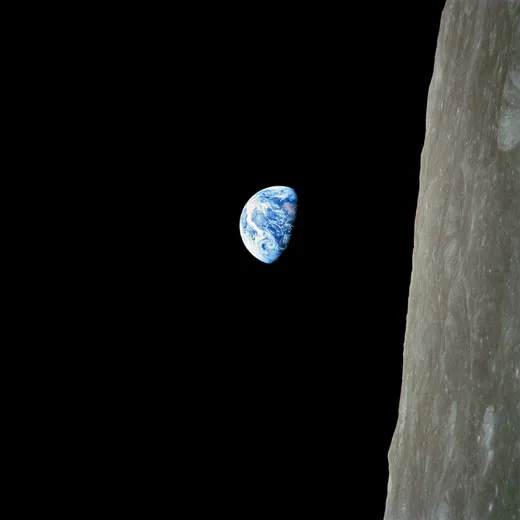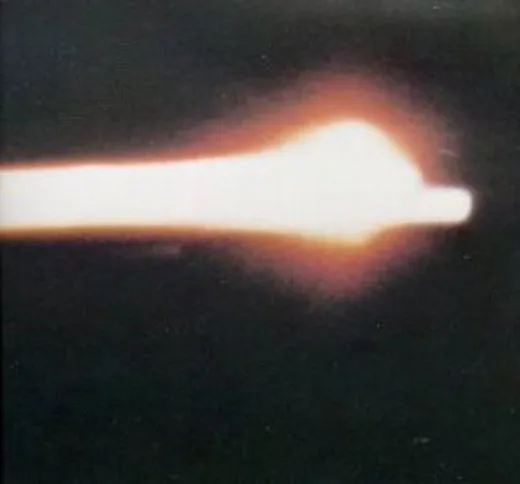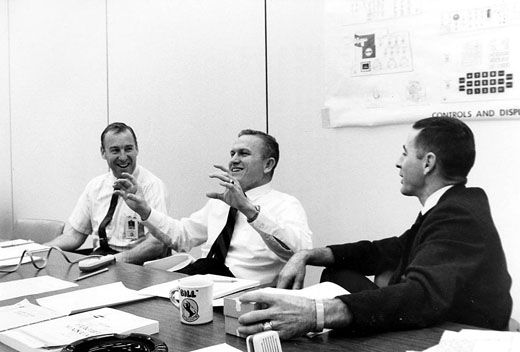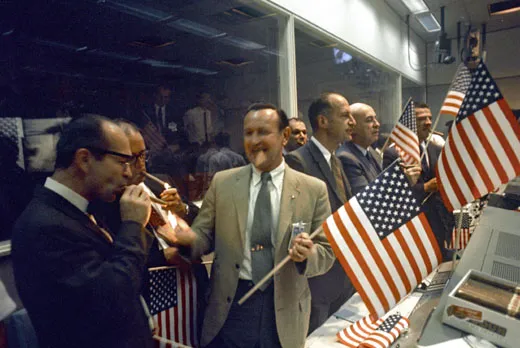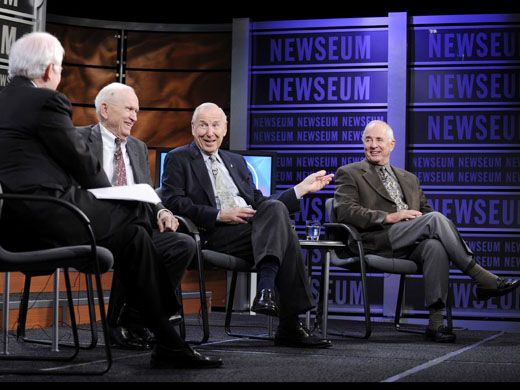To Boldly Go
Sending Apollo 8 to the moon was a risky mix of cold war politics, bravery, and the faith of one man, George Low, in his engineers.
/https://tf-cmsv2-smithsonianmag-media.s3.amazonaws.com/filer/Apollo8-Crew-Flashimage.jpg)
The job was a big one—first humans to the moon—so it looked like they’d have to work the weekend. December 21, 1968, fell on a Saturday. Astronaut Jim Lovell waddled in his spacesuit across an enclosed gantry at the Kennedy Space Center in Florida. Thirty-six stories above the launch pad, he regarded the open hatch of the Apollo 8 command module. Though the vehicles that would follow had names like Gumdrop, Charlie Brown, and Apollo 11’s Columbia, this one was simply CM-103. It had as much living space as a van, and it would be Lovell’s home for the next week.
It was still dark outside. The great moon rocket, the Saturn V, taller than the Statue of Liberty and heavier than a Navy destroyer, was illuminated from the ground by searchlights. The vehicle was by far the biggest and fastest flying machine ever built, and remains so today. On that cool, clear morning, the first day of winter, no astronaut had ridden the Saturn V. It hummed with electricity and hissed with five and a half million pounds of kerosene, liquid hydrogen, and liquid oxygen, as it waited to throw men for the first time beyond Earth and into orbit around the moon.
Lovell, then 40 and a veteran of two Gemini missions, had more hours in space than any U.S. astronaut. He recently admitted during a Washington, D.C., that at that moment 40 years ago, he paused as he stared into the hatch. Rookie astronaut Bill Anders, 35, was firmly harnessed in the right couch, facing skyward. On the left, mission commander Frank Borman, 40, was also strapped in and ready for launch. “I looked at them,” said Lovell, “and I looked down at the ground, and I said, ‘These people are really serious. This is not another Earth orbital flight. This is going to the moon.’ And that maybe was the time when I said, ‘Well, here we go.’ ”
“We were three explorers doing something entirely different,” he continued. “We were going the entire distance, 240,000 miles, and we were going to see the far side of the moon.”
Apollo 8 was originally scheduled as another hardware test in Earth orbit. The decision to send it to the moon instead ranks as one of the gutsiest in the history of space exploration. The astronauts themselves believed they might have only a one-in-three chance of success.
“The genius behind the Apollo 8 mission…was a man by the name of George Low,” said Borman. Low, who died of cancer in 1984, was the NASA manager in charge of redesigning the three-man command module after the Apollo 1 fire that had killed astronauts Gus Grissom, Ed White, and Roger Chaffee in January 1967. “You couldn’t get any change in the spacecraft unless [Low] approved it,” recalled Borman. And after the redesign “there wasn’t a problem in any of the missions with the command module, ever. So it was a tribute to George Low and the people that he put together that made that work.”
Early in 1968, a year after the fire, Low came to his own This is it realization that now was the time to get serious about aiming for the moon. Born in Austria in 1926, Low had emigrated from his Nazi-occupied homeland in 1938. He served in the U.S. Army in World War II, earned a master’s degree in aeronautical engineering from Rensselaer Polytechnic Institute in 1950, and joined the National Advisory Committee for Aeronautics, the precursor to NASA. At 30, he was promoted to chief of the Special Projects Branch, where he was heavily involved in the new fields of orbit calculations and space rendezvous techniques. Two years later, when NASA was established, he was summoned to Washington, D.C., and installed as the chief of manned spaceflight. Throughout the 1960s, Low played a central role in planning the Mercury, Gemini, and Apollo missions.
After the Apollo 1 fire, NASA elevated him to manager of the Apollo Spacecraft Program. Borman was the only astronaut on the team that redesigned the craft. If there’s a single moment that can be identified as Apollo 8’s genesis, it’s an April 1968 meeting between Low and Borman, when the astronaut asserted his faith in the redesigned spacecraft. Borman was convinced the problems that had led to the Apollo 1 fire had been solved. The plan at that point was to test the command module and the new lunar module in Earth orbit on the next two flights. But after his meeting with Borman, Low began quietly considering the feasibility of a lunar orbital flight before the end of the year, and wrote a memo about it to his superiors. He told his assistant to consider the memo “007,” which meant that after it was read, she was to destroy it, and even refrain from keeping a copy for Low’s files.
Spring became summer, and the lunar orbit idea stayed in Low’s head as Apollo fell behind schedule, dogged mainly by delays with Grumman’s complex lunar lander. Competition with the Soviets also was on his mind.
“I was told that the CIA had intelligence that the Russians were going to try and put a man around [the moon] before the end of the year,” recalled Borman at the Newseum event. “And that was the reason for the change in our mission. Because, after all, the Apollo program was just a battle in the cold war.”
Recently released documents from that era show that the CIA was briefing NASA administrator James Webb regularly about Soviet plans for a lunar orbit mission by the end of 1968. According to space historian Dwayne Day, Sherman Kent, who headed the Office of National Estimates, had been providing intelligence on the Soviet space program from as early as 1965. In the mid-1960s the Soviet program had lagged behind NASA’s, but, wrote Kent, the Russians “could achieve a manned lunar landing about mid-1969 at the earliest.” And then came the setbacks for Apollo, particularly the fire.
The pace of Russian lunar missions had U.S. space planners genuinely worried. In the month prior to the April 1968 meeting between Borman and Low, the Soviets had launched the unmanned Zond 4, which had a similar configuration to the Soyuz modules designed to carry cosmonauts. Zond 4 flew out to about 200,000 miles from Earth, then turned around and executed a high-speed reentry. It came in too steeply, however, and had to be blown up over west Africa to avoid the risk of its falling into western hands. Zond 4 was followed quickly by Luna 14, an unmanned flight that entered lunar orbit on April 10—leading to speculation that a manned version would soon follow. Then, just a week later, the Soviets launched Cosmos 213 and 214, unmanned Soyuz test vehicles that succeeded in docking automatically in Earth orbit.
Amid these Soviet triumphs, the second Saturn V flight, the unmanned Apollo 6, was launched on April 4, 1968. During the first stage burn, it suffered violent “pogo” oscillations that would have injured a crew. Then two of the five second-stage engines shut down prematurely. Finally, the third-stage engine failed to relight when commanded to, rendering the mission a failure.
Low was watching the calendar. President Kennedy’s deadline for a lunar landing—“before this decade is out”—was hardly more than a year and a half away. Fortunately, the team led by rocket scientist Wernher von Braun at the Marshall Space Flight Center in Huntsville, Alabama, quickly addressed the pogo problem and engine failures, solving them in a matter of weeks. But the lunar module’s progress continued to slide.
That’s when Low—as detailed in his personal notes, now kept at Rensselaer—unveiled his plan.
On August 7, having learned that the lunar module test in Earth orbit might have to slip until March 1969, Low wrote, “I asked Chris Kraft [director of flight operations] to look into the feasibility of a lunar orbit mission on AS 503 [the next available Saturn V booster].”
Two days later, Low met with Bob Gilruth, the director of the Manned Spacecraft Center (now the Johnson Space Center) in Houston. At 8:45 a.m., according to his notes, Low told Gilruth he’d been considering the possibility of a lunar orbit mission with Saturn number AS 503, and got a very enthusiastic response. Fifteen minutes later, Kraft indicated that his preliminary studies showed a lunar orbit mission was feasible. With that, Low called a meeting of Gilruth, Kraft, and, representing the astronaut office, Deke Slayton. “After considerable discussion, we agreed that this mission should certainly be given serious consideration,” he wrote, “and that we saw no reason at the present time why it should not be done. We immediately decided that it was important to get both von Braun and [Sam] Phillips [the Apollo program director at NASA headquarters in Washington] on board in order to obtain their endorsement and enthusiastic support.” The men made a flurry of calls, and an in-person meeting was arranged.
By that afternoon, Friday, August 9, a dozen of the top decision makers in the Apollo program had flown from Florida, Texas, and Washington to Huntsville. They convened in von Braun’s office at 2:30. Low ran the meeting, selling the group immediately on his idea to send astronauts to orbit the moon within four months. The meeting ended with high morale, and with an agreement to get together in Washington on August 14.
In the days that followed, Kraft worked out the best available window for a daylight launch, which fell between December 20 and 26. Slayton visited Borman on Saturday, August 10, and asked if he’d like to take the mission. He got an enthusiastic yes. Other technical issues, such as how to make up for the weight of the missing lunar lander on the Saturn rocket (it wouldn’t be needed for an orbital mission), were raised and solved.
At the August 14 meeting in Washington, NASA Deputy Administrator Tom Paine pressed the Apollo managers as to whether they’d really considered all the risks of a lunar orbital mission. In his notes, Low recorded the comments around the table. Speaking for the rocket team, Von Braun said, “Once a decision has been made to fly a man on [Saturn number] 503, it doesn’t matter to the launch vehicle how far we go.” Slayton said, “This is the only chance to get to the moon before the end of 1969. It is a natural thing to do.” Kraft thought: “Probably the flight operations people have the most difficult job in this…. But I have every confidence in our doing it.” Low himself concluded with “The question is not whether we can afford to do it; it should be can we afford not to do it.”
There was still one obstacle—convincing Administrator Webb and George Mueller, Deputy Administrator for Manned Space Flight, who were in Vienna at a space conference. That proved trickier than the technical hurdles. On the 13th, Phillips had called Mueller in Vienna and gotten a very cool response to the plan, while Webb, he recalled later, “was clearly shaken by the abrupt proposal and by the consequences of possible failure.” But with two more days of negotiating by phone, the team of managers led by Low convinced Webb and Mueller, via Phillips, of the plan’s technical and political benefits. They promised that it would go forward only if Apollo 7 (a critical October checkout of the redesigned command module) was successful. It flew a virtually flawless mission, October 11 through 22, marred only by a round of head colds that afflicted the crew.
The Soviets were keeping pace, barely. The unmanned Zond 5, another Soyuz-borne test craft capable of carrying cosmonauts, launched on September 15. It became the first vehicle to fly past the moon and return to Earth. Though it fell short of Soviet territory, landing in the Indian Ocean, the Soviets recovered it, and found its cargo of turtles, flies, worms, and plants alive and healthy. This was followed on October 22 by cosmonaut Georgi Beregovoi’s flight on Soyuz 2, the first Soviet manned shot in a year and a half. During four days in Earth orbit, he maneuvered close to a Soyuz target vehicle, and returned safely.
On November 12, Paine, by then the new NASA administrator, announced to the world that Apollo 8’s mission had changed, and that it would take Borman, Lovell, and Anders into orbit around the moon on Christmas Eve. The announcement was made two days after the launch of Zond 6, another unmanned lunar orbital flight. The Soviets surprised the West by announcing the Zond 6 flight before it was over. But due to a faulty rubber O-ring gasket, the capsule depressurized on its way home. It crashed onto Soviet soil, ending any hope of sending humans to the moon a few weeks later.
The Soviets never managed to send humans beyond Earth orbit. Despite the Zond missions’ reentry problems, plenty of cosmonauts were eager to go. In the ensuing years, Bill Anders would hear about it first-hand. “I met a lot of them later, in various capacities,” he recalled at the Newseum event. “One of them in particular was Alexei Leonov, who claimed, and I didn’t have any reason to doubt it, that he was the cosmonaut selected to fly on the flight that the Russians didn’t approve that would have beat us around the moon.
“He was very unhappy that they didn’t let him go.”
